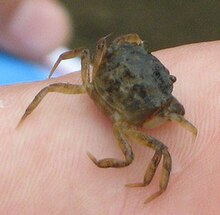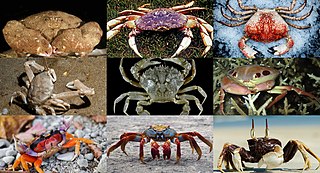
Crabs are decapod crustaceans of the infraorder Brachyura, which typically have a very short projecting tail-like abdomen, usually hidden entirely under the thorax. They live in all the world's oceans, in freshwater, and on land. They are generally covered with a thick exoskeleton. They generally have five pairs of legs, and they have pincer claws on the ends of the frontmost pair. They first appeared during the Jurassic period, around 200 million years ago.

Panopeus herbstii, also known as the black-fingered mud crab, black-clawed mud crab, Atlantic mud crab or sometimes common mud crab, is a species of true crab, belonging to the infraorder Brachyura, and is the largest of the mud crabs.
Mud crab may refer to any crab that lives in or near mud, such as:

Isopoda is an order of crustaceans. Members of this group are called isopods and include both aquatic species, and terrestrial species such as woodlice. All have rigid, segmented exoskeletons, two pairs of antennae, seven pairs of jointed limbs on the thorax, and five pairs of branching appendages on the abdomen that are used in respiration. Females brood their young in a pouch under their thorax called the marsupium.

The Japanese spider crab is a species of marine crab and is the biggest one that lives in the waters around Japan. At around 3.7 meters, it has the largest leg-span of any arthropod. The Japanese name for this species is taka-ashi-gani,, literally translating to “tall legs crab”. It goes through three main larval stages along with a prezoeal stage to grow to its great size.

Eucarida is a superorder of the Malacostraca, a class of the crustacean subphylum, comprising the decapods, krill, and Angustidontida. They are characterised by having the carapace fused to all thoracic segments, and by the possession of stalked eyes.
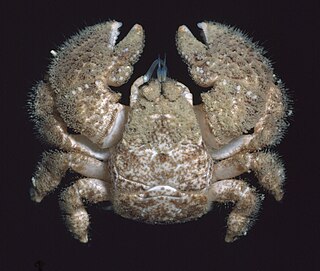
The hairy stone crab is a crab-like anomuran crustacean that lives in the littoral zone of southern Australia from Bunbury, Western Australia, to the Bass Strait. It is the only species in the family Lomisidae. It is 1.5–2.5 cm (0.6–1.0 in) wide, slow-moving, and covered in brown hair which camouflages it against the rocks upon which it lives.

Xanthoidea is a superfamily of crabs, comprising seven families. Formerly, a number of other families were included in Xanthoidea, but many of these have since been removed to other superfamilies. These include Carpilioidea, Eriphioidea, Hexapodoidea, Pilumnoidea and Trapezioidea. Even in this reduced state, Xanthoidea remains one of the most species-rich superfamilies of crabs.
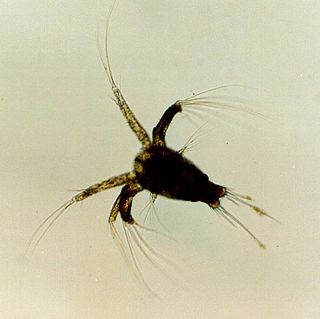
Crustaceans may pass through a number of larval and immature stages between hatching from their eggs and reaching their adult form. Each of the stages is separated by a moult, in which the hard exoskeleton is shed to allow the animal to grow. The larvae of crustaceans often bear little resemblance to the adult, and there are still cases where it is not known what larvae will grow into what adults. This is especially true of crustaceans which live as benthic adults, more-so than where the larvae are planktonic, and thereby easily caught.

Panopeus is a genus of crabs, containing these extant species:

The Panopeidae are a family containing 26 genera of morphologically similar crabs, often known as "mud crabs". Their centers of diversity are the Atlantic Ocean and eastern Pacific Ocean.

Dyspanopeus sayi is a species of mud crab that is native to the Atlantic coast of North America. It has also become established outside its native range, living in Swansea Docks since 1960, the Mediterranean Sea since the 1970s, the North Sea since 2007 and the Black Sea since 2010. It can reach a carapace width of 20 mm (0.8 in), and has black tips to its unequal claws. It feeds on bivalves and barnacles, and is in turn eaten by predators including the Atlantic blue crab, Callinectes sapidus. Eggs are produced from spring to autumn, the offspring reach sexual maturity the following summer, and individuals can live for up to two years. The closest relative of D. sayi is D. texanus, which lives in the Gulf of Mexico; the two species differ in subtle features of the genitalia and the last pair of walking legs.
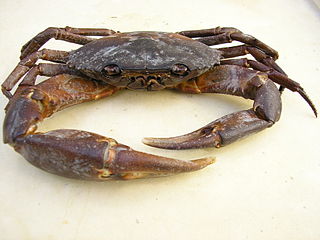
Eurytium is a genus of crab in the family Panopeidae, containing the following four species:
Austin Beatty Williams was an American carcinologist, "the acknowledged expert on and leader in studies of the systematics of eastern American decapod crustaceans".

Dyspanopeus texanus is a species of crab known as the Texas mud crab.

Petrolisthes armatus, the green porcelain crab, is a species of small porcelain crab in the family Porcellanidae. It is believed to be native to Brazil but has spread to other parts of the world. Populations in the south eastern part of the United States have increased dramatically and the species is considered to be an invasive species.
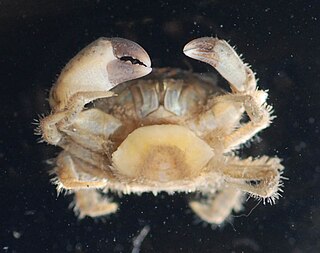
Loxothylacus panopaei is a species of barnacle in the family Sacculinidae. It is native to the Gulf of Mexico and the Caribbean Sea. It is a parasitic castrator of small mud crabs in the family Panopeidae, mostly in the Gulf of Mexico, the Caribbean Sea and the eastern Atlantic Ocean.
Panopeus lacustris, the knot-fingered mud crab, is a true crab belonging to the infraorder Brachyura. It can be distinguished from related species by its exceptionally broad and knobbly main chela (claw).
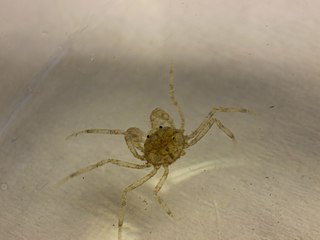
Limnopilos is a genus of small hymenosomatid crabs endemic to Southeast Asia. The genus was described by Christina Chuang and Peter Ng in 1991, who identified the new species Limnopilos naiyanetri and distinguished it from the closely related genus Hymenicoides. Its true taxonomic classification was debated for several years, but in 2007 the discovery of a new species of crab in this genus solidified the distinction between Limnopilos and Hymenicoides. Many aspects of the genus Limnopilos are still poorly understood. Their ecology and natural history have not been studied in detail, and their reproductive cycle remains mysterious.
